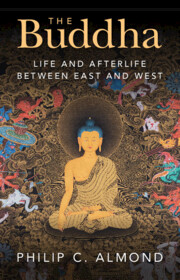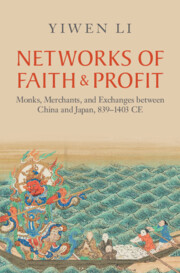158 results
Invoking the Goddess along the Southern Silk Roads: a transregional survey of Prajñāpāramitā protective texts
-
- Journal:
- Journal of the Royal Asiatic Society , First View
- Published online by Cambridge University Press:
- 27 May 2024, pp. 1-15
-
- Article
- Export citation
7 - Sexuality in Traditional Systems of Thought and Belief in Pre-modern Japan
-
-
- Book:
- The Cambridge World History of Sexualities
- Published online:
- 26 April 2024
- Print publication:
- 16 May 2024, pp 136-157
-
- Chapter
- Export citation
11 - Sexuality in Buddhist Traditions
-
-
- Book:
- The Cambridge World History of Sexualities
- Published online:
- 26 April 2024
- Print publication:
- 16 May 2024, pp 228-249
-
- Chapter
- Export citation
Chapter 27 - The German Study of India and Buddhism
- from IV - Life, Language, and the Ancient World
-
-
- Book:
- Wagner in Context
- Published online:
- 14 March 2024
- Print publication:
- 14 March 2024, pp 267-274
-
- Chapter
- Export citation
Transgenderism, Othering and Third Way Buddhist Monasticism in Chiang Mai, Thailand
-
- Journal:
- TRaNS: Trans-Regional and -National Studies of Southeast Asia , First View
- Published online by Cambridge University Press:
- 02 February 2024, pp. 1-13
-
- Article
- Export citation
13 - Religion in the Tokugawa Period
- from Part III - Social Practices and Cultures of Early Modern Japan
-
-
- Book:
- The New Cambridge History of Japan
- Published online:
- 15 January 2024
- Print publication:
- 23 November 2023, pp 443-477
-
- Chapter
- Export citation
6 - Connecting Orientalism and Internationalism
- from Part II - The Interwar Politics of Greater India
-
- Book:
- Visions of Greater India
- Published online:
- 09 November 2023
- Print publication:
- 23 November 2023, pp 185-213
-
- Chapter
- Export citation
4 - The Religions of India
-
- Book:
- Learning from Other Religions
- Published online:
- 30 October 2023
- Print publication:
- 16 November 2023, pp 115-167
-
- Chapter
- Export citation

The Buddha
- Life and Afterlife Between East and West
-
- Published online:
- 09 November 2023
- Print publication:
- 30 November 2023
20 - Buddhism
- from Part II - Transnational and Religious Missions and Identities
-
-
- Book:
- The Cambridge History of Nationhood and Nationalism
- Published online:
- 08 November 2023
- Print publication:
- 09 November 2023, pp 437-458
-
- Chapter
- Export citation

Learning from Other Religions
-
- Published online:
- 30 October 2023
- Print publication:
- 16 November 2023
9 - HMS Bacchante
- from Part IV - Travelling the World
-
-
- Book:
- Victorian Engagements with the Bible and Antiquity
- Published online:
- 28 September 2023
- Print publication:
- 12 October 2023, pp 235-258
-
- Chapter
- Export citation
Becoming a nun in the absence of her husband: male migration and female religiosity in nineteenth-century China
-
- Journal:
- International Journal of Asian Studies / Volume 21 / Issue 1 / January 2024
- Published online by Cambridge University Press:
- 09 October 2023, pp. 128-145
-
- Article
-
- You have access
- Open access
- HTML
- Export citation
From cakravartin to bodhisattva: Buddhist models for globalization
-
- Journal:
- Journal of Global History / Volume 18 / Issue 3 / November 2023
- Published online by Cambridge University Press:
- 09 October 2023, pp. 426-438
- Print publication:
- November 2023
-
- Article
- Export citation
22 - South Asia and the Mongol Empire
- from Volume I Part 4 - External Histories
-
-
- Book:
- The Cambridge History of the Mongol Empire
- Published online:
- 01 January 2024
- Print publication:
- 17 August 2023, pp 827-851
-
- Chapter
- Export citation
10 - Religious Exchange
- from Volume I Part 2 - Thematic Histories
-
-
- Book:
- The Cambridge History of the Mongol Empire
- Published online:
- 01 January 2024
- Print publication:
- 17 August 2023, pp 525-549
-
- Chapter
- Export citation
6 - Religious Transformations
-
- Book:
- Middle Imperial China, 900–1350
- Published online:
- 20 July 2023
- Print publication:
- 03 August 2023, pp 143-166
-
- Chapter
- Export citation
7 - Conclusions
-
- Book:
- Contracting in Japan
- Published online:
- 10 August 2023
- Print publication:
- 27 July 2023, pp 187-190
-
- Chapter
- Export citation
1 - Introduction
-
- Book:
- Networks of Faith and Profit
- Published online:
- 25 May 2023
- Print publication:
- 08 June 2023, pp 1-20
-
- Chapter
- Export citation

Networks of Faith and Profit
- Monks, Merchants, and Exchanges between China and Japan, 839–1403 CE
-
- Published online:
- 25 May 2023
- Print publication:
- 08 June 2023



